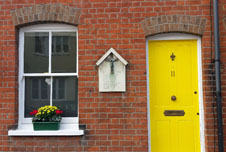
Rare First World War memorials given Grade II listings
Five First World War wall-mounted memorial plaques have been awarded a Grade II listing following an application by St Albans City and District Council. The listing was awarded by the Government Department for Culture, Media and Sport on the advice of Historic England.
They form part of a unique group of 10 memorial plaques located in streets within the parish of St Albans Abbey. Each plaque lists the names of men who died in the war and who lived in the street in which they are located.
The plaques are unusual because they are attached to the homes of some of men who lost their lives in the war. As such, they offer a private memorial compared to monuments more usually found in prominent locations.
Three of the 10 plaques were listed some time ago. The five newly-listed plaques were awarded Grade II status as part of Historic England’s project to mark the centenary of the outbreak of the First World War. The public body that looks after England’s historic environment is aiming to add 2,500 war memorials to the National Heritage List of England (NHLE) by 2019.
Four of the newly-listed plaques are located in Albert Street, Lower Dagnall Street, Pageant Road and Sopwell Lane. The fifth plaque is on the corner of Bardwell Road and Thorpe Road. The houses providing wall mounts for the plaques are not included in the listing.
These memorial plaques are among 40 war memorials in St Albans.
Cllr Julian Daly, Portfolio Holder for Planning and Conservation and Leader of St Albans City and District Council, said: “St Albans is steeped in history and the Grade II listing for these five war memorials highlights the importance of our heritage. These plaques provide a moving memorial to the tragic impact of world events on ordinary people and the sacrifices the community made during the First World War.”
Tony Calladine, Historic England’s Head of Designation for the East of England, said: "We are pleased that these rare war memorial plaques have been listed at Grade II. This is part of a Historic England (previously English Heritage) scheme to list up to 2,500 war memorials over the next five years to mark the centenary of the First World War. Built in the years following the conflict, they are a poignant, physical reminder of the terrible sacrifices and loss the First World War brought about.”
As part of the national First World War commemorations, a Victoria Cross commemorative stone was also laid at St Peter’s Street war memorial this year. This was in honour of St Albans-born Private Edward Warner who was awarded a Victoria Cross for his bravery after successfully defending a trench from attack.
Councillor contact:
Cllr Julian Daly, Portfolio Holder for Planning and Conservation and Leader of St Albans City and District Council
Mob: 07775 657200
Contact for the media:
Ruth Boyer, Communications Officer, St Albans City and District Council
Tel: 01727 819316
E-mail: ruth.boyer@stalbans.gov.uk
Follow us on Twitter: http://twitter.com/StAlbansCouncil
Notes:
1. In 2014, to mark the centenary of the outbreak of the First World War, Historic England embarked upon a five-year project to add 2,500 war memorials to the National Heritage Lift for England. More information about Historic England’s War Memorials Listing Project can be found on the website.
2. More information about all but one of the soldiers commemorated on these memorials can be found in the book, “The Street Memorials of St Albans Abbey Parish”. The book was written by Alice Goodman, revised and updated in 2015 by John G E Cox and Ann Dean. It is published by the St Albans & Hertfordshire Architectural & Archaeological Society (SAHAAS) and more information can be found on the website.
3. Private Edward (Ted) Warner was born in St Albans on 18 November 1883. His regiment was one of the first wave of British troops to arrive on the Western Front on 16 August 1914. His citation reads: “For most conspicuous bravery near ' Hill 60 ' on 1st May,1915. After Trench 46 had been vacated by our troops, consequent on a gas attack, Private Warner entered it single-handed in order to prevent the enemy taking possession. Reinforcements were sent to Private Warner, but could not reach him owing to the gas. He then came back and brought up more men, by which time he was completely exhausted, but the trench was held until the enemy's attack ceased. This very gallant soldier died shortly afterwards from the effects of gas poisoning.”
4. More information about the Government’s Victoria Cross commemorative paving stones initiative is available on the website.
Photos:
TOP: Memorial plaque at 11 Pageant Road, St Albans

ABOVE: Memorial plaque at 34 and 36 Albert Street
